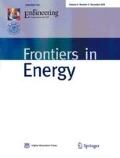Abstract
About 67 million Chinese kangs are still used by about 175 million people in China today. The kang utilizes biomass burning for space heating and hence reduces the use of commercial energy. However, the existing design of kangs is largely based on the accumulated experience of craftsmen, for lack of scientific studies and engineering design guidelines. Poor construction of kangs also leads to serious indoor air pollution. In this paper, a macroscopic smoke flow and heat transfer model of an elevated kang is integrated in a widely-used building energy analysis software in China-DeST, and the integrated software can be used for the thermal performance analysis of kang-integrated houses. A typical house with kangs in various villages of northern China is chosen as a case study. The annual performance of the kang under different insulations of building envelope and climatic conditions are discussed. Based on the simulation results, it is found that the thermal comfort requirement of the outside surface of the upper kang plate can be met by a proper construction of the kang and selection of the appropriate firing pattern. The better the insulation of the building envelope is or the better the room air tightness is, the greater the indoor air temperature rise and the greater the building heating load contribution of the kang. In the eight selected cities in northern China, the use of kang can meet 50%–80% of the house heating load.
Similar content being viewed by others
References
Men R. Origin of everything. Beijing: China Economy Press, 2004 (in Chinese)
Chen B, Zhuang Z, Chen X, Jia X. Field survey of indoor thermal environment of rural residences with coupled Chinese kang and passive solar wall heating in northeast China. Solar Energy, 2007, 81(6): 781–790
Yang Shaohai. Survey study on kangs. In proceedings of civil and architectural institute of northern China, Harbin, 1963 (in Chinese)
Deguchi K, Sanda T. Thermal environment of private houses with traditional heating system in northern China. Summaries of Technical Papers of Annual Meeting Architectural Institute of Japan, Japan, 2002, 583–584
DeST Group of Tsinghua University. Building environmental system simulation and analysis-DeST. Beijing: China Architecture Industry Press, 2006 (in Chinese)
Li Y, Delsante A. Natural ventilation induced by combined wind and thermal forces. Building and Environment, 2001, 36(1): 59–71
Andersen K. Theory for natural ventilation by thermal buoyancy in one zone with uniform temperature. Building and Environment, 2003, 38(11): 1281–1289
Patankar S V. Numerical Heat Transfer and Fluid Flow. Washington: Hemisphere Publishing Corporation, 1980
Zhuang Zhi, Li Yuguo, Chen Bin. Smoke flows in Chinese kangs. Indoor and Built Environment, 2009, 18(3): 219–233
Zhuang Zhi, Li Yuguo, Chen Bin. A mathematical model for a house integrated with an elevated Chinese kang heating system. In the 10th International Building Performance Simulation Association Conference and Exhibition, Beijing, 2007
Yan Da, Xia Jianjun, Tang Waiyin, Song Fangting, Zhang Xiaoliang, Jiang Yi. DeST—an integrated building simulation toolkit part I: fundamentals. Building Simulation, 2008, 1(2): 95–110
Zhang Xiaoliang, Xia Jianjun, Jiang Ziyan, Huang Jiyi, Qin Rong, Zhang Ye, Liu Ye, Jiang Yi. DeST—an integrated building simulation toolkit part II: applications. Building Simulation, 2008, 1(3): 193–209
Zheng Zhuling. Heating energy analysis and comparison of the typical rural housing in northern China. Dissertation for the Master’s Degree, Beijing: Tsinghua University, 2007 (in Chinese)
Zhuang Zhi. Smoke flow and thermal performance of Chinese kang. Dissertation for the Doctoral Degree. Dalian: Dalian University of Technology, 2009 (in Chinese)
Zhuang Zhi, Li Yuguo, Duanmu Lin, Wang Zongshan, Chen Bin, Qian Hua, Sun Yafeng, Zhao Yang, Liu Li. Experimental assessment of thermal performance of an elevated Chinese kang system. The First International Conference on Building Energy and Environment, Dalian, 2008
Guo Jiye. The structure of elevated kangs as well as material selection. New Agriculture, 2001, (3): 42–43 (in Chinese)
China Academy of Building Research. Floor radiant heating technology regulation (JGJ142-2004). Ministry of Housing and Urban-Rural Development of the People’s Republic of China, 2004 (in Chinese)
Zhuang Z, Li Y, Chen B. Thermal storage performance analysis on Chinese kangs. Energy and Buildings, 2009, 41(4): 452–459
National Meteorological Information Center and Department of Building Science of Tsinghua University. China Special Climate Database for Building Thermal Environment Analysis. Beijing: China Architecture Industry Press, 2005 (in Chinese)
Author information
Authors and Affiliations
Corresponding author
Rights and permissions
About this article
Cite this article
Zhuang, Z., Li, Y., Yang, X. et al. Thermal and energy analysis of a Chinese kang. Front. Energy Power Eng. China 4, 84–92 (2010). https://doi.org/10.1007/s11708-010-0009-x
Received:
Accepted:
Published:
Issue Date:
DOI: https://doi.org/10.1007/s11708-010-0009-x




